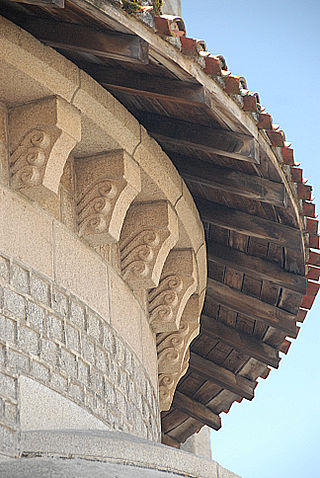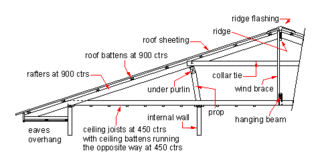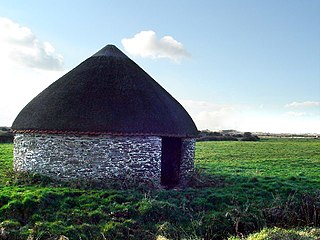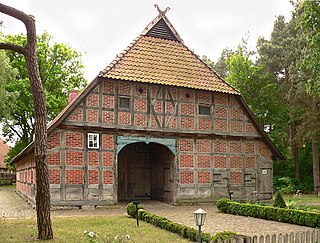A roof is the top covering of a building, including all materials and constructions necessary to support it on the walls of the building or on uprights, providing protection against rain, snow, sunlight, extremes of temperature, and wind. A roof is part of the building envelope.

A wall is a structure and a surface that defines an area; carries a load; provides security, shelter, or soundproofing; or, is decorative. There are many kinds of walls, including:

A barn is an agricultural building usually on farms and used for various purposes. In North America, a barn refers to structures that house livestock, including cattle and horses, as well as equipment and fodder, and often grain. As a result, the term barn is often qualified e.g. tobacco barn, dairy barn, cow house, sheep barn, potato barn. In the British Isles, the term barn is restricted mainly to storage structures for unthreshed cereals and fodder, the terms byre or shippon being applied to cow shelters, whereas horses are kept in buildings known as stables. In mainland Europe, however, barns were often part of integrated structures known as byre-dwellings. In addition, barns may be used for equipment storage, as a covered workplace, and for activities such as threshing.

A shed is typically a simple, single-story roofed structure, often used for storage, for hobbies, or as a workshop, and typically serving as outbuilding, such as in a back garden or on an allotment. Sheds vary considerably in their size and complexity of construction, from simple open-sided ones designed to cover bicycles or garden items to large wood-framed structures with shingled roofs, windows, and electrical outlets. Sheds used on farms or in the industry can be large structures. The main types of shed construction are metal sheathing over a metal frame, plastic sheathing and frame, all-wood construction, and vinyl-sided sheds built over a wooden frame. Small sheds may include a wooden or plastic floor, while more permanent ones may be built on a concrete pad or foundation. Sheds may be lockable to deter theft or entry by children, domestic animals, wildlife, etc.

In architecture, a cornice is generally any horizontal decorative moulding that crowns a building or furniture element—for example, the cornice over a door or window, around the top edge of a pedestal, or along the top of an interior wall. A simple cornice may be formed with a crown, as in crown moulding atop an interior wall or above kitchen cabinets or a bookcase.

A gazebo is a pavilion structure, sometimes octagonal or turret-shaped, often built in a park, garden, or spacious public area. Some are used on occasions as bandstands.

The eaves are the edges of the roof which overhang the face of a wall and, normally, project beyond the side of a building. The eaves form an overhang to throw water clear of the walls and may be highly decorated as part of an architectural style, such as the Chinese dougong bracket systems.

A batten is most commonly a strip of solid material, historically wood but can also be of plastic, metal, or fiberglass. Battens are variously used in construction, sailing, and other fields.

A hut is a small dwelling, which may be constructed of various local materials. Huts are a type of vernacular architecture because they are built of readily available materials such as wood, snow, ice, stone, grass, palm leaves, branches, clay, hides, fabric, or mud using techniques passed down through the generations.

Domestic roof construction is the framing and roof covering which is found on most detached houses in cold and temperate climates. Such roofs are built with mostly timber, take a number of different shapes, and are covered with a variety of materials.

A circular linhay is an ancient type of structure found in England, particularly associated with Devon. Linhay, also spelt Linny, is a type of farm building with an open front and usually a lean-to roof. In Newfoundland English a linney is similar to a storage space, kitchen, or porch but as an addition to the rear of a house, and in American English it is an open, lean-to shed attached to a farmyard. Linhays were used to store hay above and shelter cattle or farm machinery.

The Low German house or Fachhallenhaus is a type of timber-framed farmhouse found in northern Germany and the easternmost Netherlands, which combines living quarters, byre and barn under one roof. It is built as a large hall with bays on the sides for livestock and storage and with the living accommodation at one end.

Pole framing or post-frame construction is a simplified building technique that is an alternative to the labor-intensive traditional timber framing technique. It uses large poles or posts buried in the ground or on a foundation to provide the vertical structural support, along with girts to provide horizontal support. The method was developed and matured during the 1930s as agricultural practices changed, including the shift toward engine-powered farm equipment and the demand for cheaper, larger barns and storage areas.

A linhay is a type of farm building found particularly in Devon and Somerset, south-west England. It is characterised as a two-storeyed building with an open front, with tallet or hay-loft above and livestock housing below. It often has a lean-to roof, and the front generally consists of regularly-spaced pillars or columns. Cattle linhays were used to house cattle in the winter with hay storage above. Owing to the wide, open front, hay was easily thrown up into the tallet for storage after hay-making by a man standing on a hay-cart using a pitch-fork. The hay was kept dry by the roof while at the same time acting as insulation for the livestock below, and was easily fed as daily rations to the cattle below by dropping it through openings in the floor directly into hay racks accessible to the livestock. A cart linhay stored carts and other farm machinery in place of livestock, with hay above.
Paridera is a Spanish word that in sheep husbandry refers to the lambing season. It also refers to buildings intended for the care of ewes and goats. In Spain, there are such buildings from the 17th through 19th centuries that have been converted into houses or hotels. Other abandoned Parideras in some areas are protected by law as refuge for animals species.

Mitchell railway station is located on the Western line in the Maranoa Region, Queensland, Australia. It serves the town of Mitchell. The station has one platform, opening in 1885. The station has a number of heritage-listed buildings, including the passenger station in Oxford Street, the goods shed in Alice Street, and the station master's house in Sheffield Street. The buildings were added to Queensland Heritage Register on 8 September 2005.

Maryborough railway station is a heritage-listed railway station at Lennox Street, Maryborough, Fraser Coast Region, Queensland, Australia. It is on the North Coast line serving the city of Maryborough. It was designed by Chief Engineer of the Queensland Railways Department and built from 1878 to 1890 by John Roddam & John Walker. It was added to the Queensland Heritage Register on 21 October 1992.

North Chatham Historic District is a historic district consisting of most or all of the hamlet of North Chatham in Columbia County, New York. It was listed on the National Register of Historic Places in 2023.

Old Laura Homestead is a heritage-listed homestead in Rinyirru National Park, Lakefield, Shire of Cook, Queensland, Australia. It was built from 1902 onwards. It was added to the Queensland Heritage Register on 28 July 2000.




















